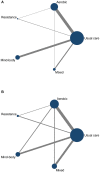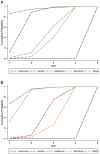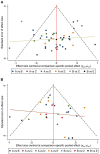Comparing the efficacy of different types of exercise for the treatment and prevention of depression in youths: a systematic review and network meta-analysis
- PMID: 37333923
- PMCID: PMC10272399
- DOI: 10.3389/fpsyt.2023.1199510
Comparing the efficacy of different types of exercise for the treatment and prevention of depression in youths: a systematic review and network meta-analysis
Erratum in
-
Corrigendum: Comparing the efficacy of different types of exercise for the treatment and prevention of depression in youths: a systematic review and network meta-analysis.Front Psychiatry. 2023 Oct 10;14:1304302. doi: 10.3389/fpsyt.2023.1304302. eCollection 2023. Front Psychiatry. 2023. PMID: 37900295 Free PMC article.
Abstract
Purpose: Depression disorder is the most commonly diagnosed type of mental illness among youths. Although a plethora of evidence suggests a positive relationship between exercise and lower levels of depression in youths, the findings regarding the variation in magnitude of this relationship are inconclusive with respect to the preventive and therapeutic effects of different types of exercise. This network meta-analysis aimed to determine the best type of exercise for the treatment and prevention of depression in youths.
Methods: A comprehensive search of databases, including PubMed, EMBASE, The Cochrane Library, Web of Science, PsychINFO, ProQuest, Wanfang, and CNKI, was conducted to identify relevant research on exercise interventions for depression in youth populations. The risk of bias in the included studies was evaluated using Cochrane Review Manager 5.4 according to the Cochrane Handbook 5.1.0 Methodological Quality Evaluation Criteria. The network meta-analysis was performed using STATA 15.1 to calculate the standardized mean difference (SMD) of all concerned outcomes. The node-splitting method was used to test the local inconsistency of the network meta-analysis. Funnel plots were used to evaluate the potential impact of bias in this study.
Result: Utilizing data extracted from 58 studies (10 countries, 4,887 participants), we found that for depressed youths, exercise is significantly better than usual care in reducing anxiety (SMD = -0.98, 95% CI [-1.50, -0.45]). For non-depressed youths, exercise is significantly better than usual care in reducing anxiety (SMD = -0.47, 95% CI [ -0.66, -0.29]). In the treatment of depression, resistance exercise (SMD = -1.30, 95% CI [ -1.96, -0.64]), aerobic exercise (SMD = -0.83, 95% CI [-1.10 -0.72]), mixed exercise (SMD = -0.67, 95% CI [-0.99, -0.35]), and mind-body exercise (SMD = -0.61, 95% CI [-0.84, -0.38]) all showed significant efficacy over usual care. For the prevention of depression, resistance exercise (SMD = -1.18, 95% CI [-1.65, -0.71]), aerobic exercise (SMD = -0.72, 95% CI [-0.98, -0.47]), mind-body exercise (SMD = -0.59, 95% CI [-0.93, -0.26]), and mixed exercise (SMD = -1.06, 95% CI [-1.37 to -0.75]) were all significantly effective compared to usual care. According to the test of the surface under the cumulative ranking score (SUCRA), the ranking of exercises for the treatment of depression in depressed youths is as follows: resistance exercise (94.9%) > aerobic exercise (75.1%) > mixed exercise (43.8%) > mind-body exercise (36.2%) > usual care (0%). For the prevention of depression in non-depressed youths, resistance exercise (90.3%) > mixed exercise (81.6%) > aerobic exercise (45.5%) > mind-body exercise (32.6%) > usual care (0%). Resistance exercise thus had the best comprehensive effect on both the treatment and prevention of depression in youths (clusterank value = 1914.04). Subgroup analyses show that a frequency of 3-4 times per week, a duration of 30-60 min, and a length of more than 6 weeks were found to be the most effective interventions for depression (P > 0.001).
Conclusion: This study provides compelling evidence that exercise is a viable intervention for improving depression and anxiety in young individuals. In addition, the study emphasizes the importance of selecting the appropriate type of exercise to optimize treatment and prevention. Specifically, the results suggest that resistance exercise, performed 3-4 times per week, with sessions lasting 30-60 min and a length of more than 6 weeks, yields optimal results for the treatment and prevention of depression in young individuals. These findings have significant implications for clinical practice, particularly given the challenges associated with implementing effective interventions and the economic burden of treating and preventing depression in young people. However, it is worth noting that additional head-to-head studies are necessary to confirm these findings and strengthen the evidence base. Nevertheless, this study provides valuable insights into the role of exercise as a potential treatment and preventative measure for depression in young people.
Systematic review registration: https://www.crd.york.ac.uk/PROSPERO/display_record.php?RecordID=374154, identifier: 374154.
Keywords: anxiety; depression; exercise; prevention; treatment; youth.
Copyright © 2023 Zhang, Li, Liu, Guan, Zhang and Shi.
Conflict of interest statement
The authors declare that the research was conducted in the absence of any commercial or financial relationships that could be construed as a potential conflict of interest.
Figures






Similar articles
-
Optimal exercise dose and type for improving sleep quality: a systematic review and network meta-analysis of RCTs.Front Psychol. 2024 Oct 3;15:1466277. doi: 10.3389/fpsyg.2024.1466277. eCollection 2024. Front Psychol. 2024. PMID: 39421847 Free PMC article.
-
Comparative efficacy of different exercise modalities on metabolic profiles and liver functions in non-alcoholic fatty liver disease: a network meta-analysis.Front Physiol. 2024 Sep 11;15:1428723. doi: 10.3389/fphys.2024.1428723. eCollection 2024. Front Physiol. 2024. PMID: 39376897 Free PMC article.
-
Effects of different Chinese traditional exercises on mental health during the COVID-19 pandemic: a systematic review and meta-analysis.Front Public Health. 2024 Jul 31;12:1420035. doi: 10.3389/fpubh.2024.1420035. eCollection 2024. Front Public Health. 2024. PMID: 39145160 Free PMC article.
-
Effects of mind-body therapies on depression among adolescents: a systematic review and network meta-analysis.Front Public Health. 2024 Jul 10;12:1431062. doi: 10.3389/fpubh.2024.1431062. eCollection 2024. Front Public Health. 2024. PMID: 39050611 Free PMC article.
-
Effects of physical exercise on anxiety depression and emotion regulation in children with attention deficit hyperactivity disorder: a systematic review and meta-analysis.Front Pediatr. 2025 Jan 7;12:1479615. doi: 10.3389/fped.2024.1479615. eCollection 2024. Front Pediatr. 2025. PMID: 39840316 Free PMC article.
Cited by
-
Relationship between Depression and Physical Activity Frequency in Spanish People with Low, Medium, and High Pain Levels.J Pers Med. 2024 Aug 12;14(8):855. doi: 10.3390/jpm14080855. J Pers Med. 2024. PMID: 39202046 Free PMC article.
-
The Methodological Quality of Studies on Physical Exercise in Adolescents with Cerebral Palsy: A Scoping Review of Systematic Reviews and Meta-Analyses.Healthcare (Basel). 2024 Oct 15;12(20):2039. doi: 10.3390/healthcare12202039. Healthcare (Basel). 2024. PMID: 39451454 Free PMC article.
-
Research status and trends of physical activity on depression or anxiety: a bibliometric analysis.Front Neurosci. 2024 Mar 22;18:1337739. doi: 10.3389/fnins.2024.1337739. eCollection 2024. Front Neurosci. 2024. PMID: 38586196 Free PMC article.
-
Impact of combiner aerobic and resistance training on depression: a systematic review and meta-analysis of randomized controlled trials.BMC Sports Sci Med Rehabil. 2025 Jan 23;17(1):10. doi: 10.1186/s13102-025-01058-w. BMC Sports Sci Med Rehabil. 2025. PMID: 39849618 Free PMC article.
-
The effects of physical activity on the mental health of typically developing children and adolescents: a systematic review and meta-analysis.BMC Public Health. 2025 Apr 23;25(1):1514. doi: 10.1186/s12889-025-22690-8. BMC Public Health. 2025. PMID: 40269876 Free PMC article.
References
-
- APA . Diagnostic and Statistical Manual of Mental Disorders: DSM-5™. New York, NY: American Psychiatric Publishing, Inc (2013).
-
- Vos T, Flaxman AD, Naghavi M, Lozano R, Michaud C, Ezzati M, et al. . Years lived with disability (YLDs) for 1160 sequelae of 289 diseases and injuries 1990-2010: a systematic analysis for the Global Burden of Disease Study 2010. Lancet. (2012) 380:2163–96. 10.1016/S0140-6736(12)61729-2 - DOI - PMC - PubMed
Publication types
LinkOut - more resources
Full Text Sources
Medical

